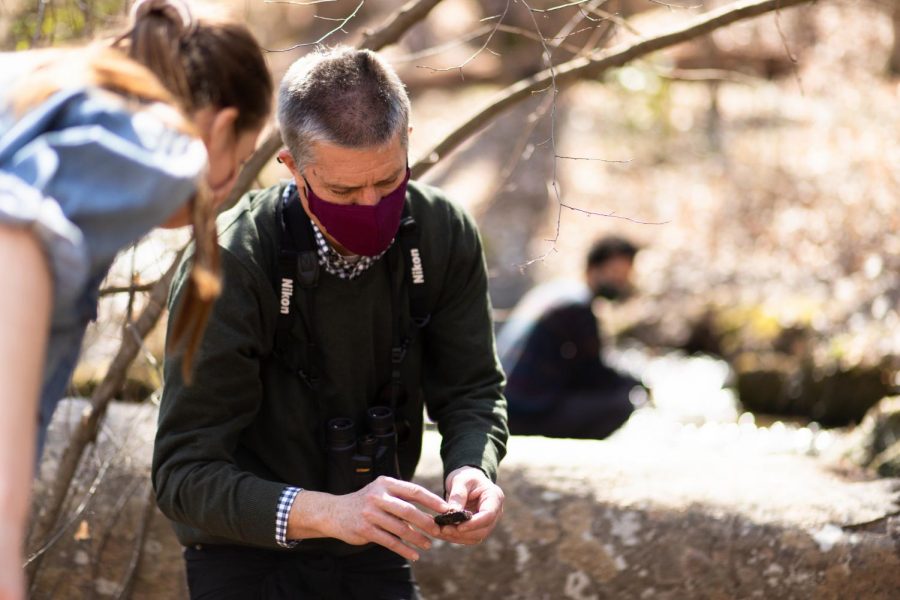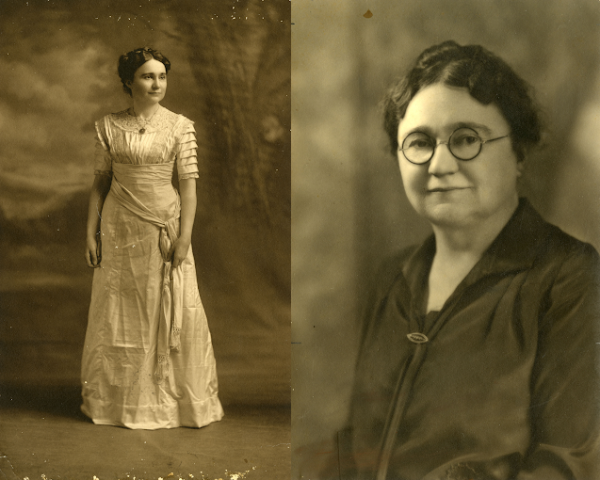Time with Jim
A reflection on learning at Guilford
Jim Hood works with a student in his American Nature Writing course this spring during a class exploration in the Guilford Woods.
Jim and I both like to talk. We’re both sitting at our computers. His hair is shorter than when we last met in January for an academic advisor conference, and he wears a black blazer over his usual plaid long-sleeve button-up. He is sitting next to a window that shines clear white light from a mid-March day into his office.
We’re meeting for a profile on how the job of interim president is fitting him. As Jim puts it, it’s been a roller coaster ride.
“One day I was Jim Hood, English professor, and the next day I was Jim Hood, interim president,” Jim says. “Since then, it’s been a whirlwind.”
“Sometime around February 21 or 22, I got a call from the chair of the Board of Trustees asking me if I would consider serving as interim president of the College,” he says while leaning an elbow against his desk, chin in palm. “I’m actually a lot calmer at the end of this week than I was three weeks ago, at the end of the first week as interim president. Because, you know, I’ve just gotten used to some things that were brand-new to me.”
I can only imagine: he’s been teaching Guilford students for over twenty years, since 1999. The change must have caused some whiplash.
My first meeting with Jim Hood—my very first meeting—came during a British Romantic Literature class in Spring 2016. I’d not adapted well to college, not one bit of it, and by my second sophomore semester I’d begun fizzling out in earnest. I missed assignment deadlines. My grades were sinking as fast as the Hindenburg post-explosion. To recoup I’d need to rock a presentation on a book I’d only read a quarter of, Jane Austin’s “Persuasion.”
Looking to fulfill class requirements, and in the hope of retaining some dignity, I turned to Jim’s office hours. We met outside, on the bench in front of Archdale Hall. Some aspects of this first meeting have stuck with me.
Jim and I figured that I might best focus on how the concept of “love” is represented within Jane Austin’s “Persuasion” and a more modern text, the 2003 film “Love Actually.” I said something like “Is this sort of writing, academic writing, worth learning how to do?” I’m sure Jim was familiar with the question for how soon and certain he answered. “It’s how we verify the quality of exploration done by the author,” he said.
He used an example of a book he’d then been near finishing, that peer reviewers were checking over. “I need to write this way so that the peer reviewers know what to expect and how to respond.”
I’m reticent about discussing my personal self. Yet get me going and I’ll go for hours — I figure that has something to do with childhood loneliness and something to do with the shame of being a “problem child,” as decreed by my kindergarten teacher. After that meeting on the bench outside Archdale with Jim, the first one-on-one meeting I recall having with him, I spent the next couple days chastising myself for using a college professor’s time to ask “Is academic writing worth learning?”
My struggle to compose written projects for school did not end with sophomore year. This very article, my final project for Spring 2021’s Guilfordian Practicum course, has seen two conceptual iterations. I first planned to write a profile of Jim, since he’d just been named Guilford College interim president.
However, after our first interview it became clear to me that a proper profile, with the requisite multiple sources and research, wouldn’t be done by the semester’s end. So I re-tuned my plans to explore the project as “a thank-you letter to Guilford College.” That didn’t quite work out either, in part due to a convergence of personal life events conspiring to exhaust me — but also out of difficulty engaging with the act of writing itself.
A charley horse cramps my brain before every attempt at composing. Call that charley horse “writer’s block” or lack of practice “exercising the writing act” or whatever you will, it exists. It is in my way.
The cramped muscles are thick and hard, a dense substance that seems permanent, walling off my desire to create from my ability to produce. Even in my senior year, the question I struggle with stretches deeper than whether academic writing is worth learning, but whether I can learn to write in the first place. The wall seems permanent.
“You’ve been away from Guilford, so I understand?” I ask Jim while rotating my right hand in circles. Jim tells me what he’s been doing.
“I finished the second year of my term as clerk of the faculty here at Guilford last year, in May 2020. It just so happened that I had a study leave approved for the fall of 2020. I had very fortunately arranged in as early as January 2020, before COVID hit, this study leave where I would teach not at Guilford but at a study-away program in southern Oregon called the Oregon Extension. The program focuses on the humanities and environmental studies, which was completely right up my alley. It also focused on experiential learning.
“I went out at the end of July to southern Oregon, to the southern tip of the Cascade Mountains, to live in a very rural part of Oregon, in a national monument, which is a preserved ecological area called the Cascade-Siskiyou National Monument, and then teach there with three other faculty and 28 students,” he said.
“That program was set up around four intensive courses. They called them different segments, but they were about four weeks long, so it’s very similar to our (Guilford’s) three-week session. Part of the reason I wanted to go out there was to get some more experience teaching in an intensive three-week, experiential learning-focused setting.
“That was a great learning experience for me, and a kind of great respite from Guilford. I came back in December, and in January I came back to teaching at the College,” Jim said.
When stuck in front of that wall, cramped up thick-as-a-brick and all, it is easy to forget the inherent nature of walls. They block one thing from another. An area, a person, a country. In the shadow cast by the wall, one consumed with fear of being stuck can become fixated on the bricks. Yet, the fact that a wall exists in the first place means something is beyond those bricks. A place unstuck, if you would, that might not exist now but can exist later. Something we can hope for.
Why do we seek education, if not in the hope that a future exists where we can use what we learn? By pursuing education, either as a student or a teacher, we pursue the future beyond what we now can see.
“How is teaching classes at the moment . . . being both professor and interim president?” I ask Jim.
It is a couple of weeks after our first meeting, at the end of March. Jim is in his office again, this time without the blazer on. I wonder that it must be a novel experience to teach and lead the College in concert with one another.
“It has been a godsend,” he says while smiling and nodding his head. “My students help me keep perspective.”
We keep talking. Jim mentions it’s been beneficial that he established rapport with his students long before he was tapped for the interim president position. Light shines through the window.
“When this semester is over, I’m going to miss my students,” he says .






